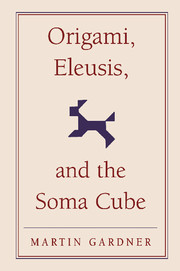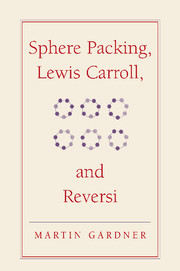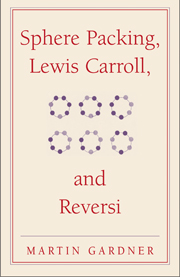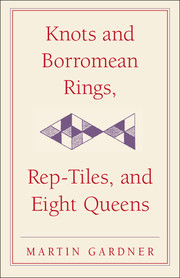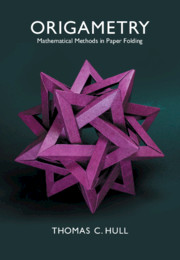Origami, Eleusis, and the Soma Cube
Martin Gardner continues to delight. He introduces readers to the Generalized Ham Sandwich Theorem, origami, digital roots, magic squares, the mathematics of cooling coffee, the induction game of Eleusis, Dudeney puzzles, the maze at Hampton Court Palace, and many more mathematical puzzles and principles. Origami, Eleusis, and the Soma Cube is the second volume in Martin Gardner's New Mathematical Library, based on his enormously popular Scientific American columns. Now the author, in consultation with experts, has added updates to all the chapters, including new game variations, mathematical proofs, and other developments and discoveries, to challenge and fascinate a new generation of readers.
- Includes expanded/revised material for every chapter
- First time reissue of entire Martin Gardner Scientific American column run
Reviews & endorsements
"Martin Gardner's fifteen volumes about Mathematical Games are The Canon - timeless classics that are always worth reading and rereading."
Don Knuth
“Gardner's monthly romp through recreational math and logic ran in Scientific American for 25 years, from the Sputnik splash to the Reagan reign, and nobody has been able to match it since. "Mathematical Games" was an orgy of right-brain tomfoolery that could be approached for superficial fun or deep insight, or both at the same time...I can't think of a better present for a clever 12-year old, bored undergraduate, restless retiree, or stay-at-home parent fearing intellectual stagnation.”
David Brooks, The Telegraph
"Legendary -- perhaps by now nearly mythical -- author of books about puzzles, magic, and the occult generally... The series presents not mere reprints, but second editions, in which Martin adds new twists, explanations, proofs, links to recent developments, illustrations, and other features."
Book News
"I recommend you approach this book on a Sunday afternoon, with paper and pen, a few biscuits for brain-power and a good hour to spare for puzzling. It is worth it."
Charlotte Mulcare, + plus Magazine
"If the essence of Martin Gardner could be distilled and injected into the authors of mathematics textbooks for K-12 students, it would be the end to the phrase “math is hard.” No one has ever demonstrated anything close to his talents for making mathematics understandable and he once again (re)shines in this book. Although I had read many of these articles several times before I opened this book, it is an irrefutable fact that any time spent reading the math of Gardner is never unproductive."
Charles Ashbacher, Journal of Recreational Mathematics
"Gardner was a model teacher of mathematics, pushing others to take interesting side explorations, solve challenging problems, and enjoy the beauty of mathematics. Thus, this reviewer applauds the republication of his genius in "The New Martin Gardner Mathematical Library" series, complete with revised explanations, new insights, up-to-date reference links, and brief surveys of recent discoveries... it is worth getting the new editions and sharing these new gems!"
J. Johnson, Choice Magazine
"Gardner offers something for everyone. The ten chapters in this volume are a wonderful part of Martin Gardner's work, each updated with selections from the enormous correspondence he enjoyed with his readers. This collection of Gardner's writing should be a cornerstone of a personal library for mathematicians, teachers and students everywhere."
Japeth Wood, Mathematical Reviews
"One of Gardner's real strengths as a writer of popular mathematics is his ability to choose topics that will appeal to the general public while also having some real mathematical content. Like the first volume, this one is in the "must have" category."
Fernando Q. Gouvea, MAA Reviews
"Many articles may be of interest even to the (mathematically sophisticated) readers of my column since (1) they are so well written, (2) they are classic, and (3) there is often a kernel of knowledge that you didn't quite know."
William Gasarch, SIGACT News
"While Martin Gardner has always called himself "strictly a journalist," he should really be honored as one of this country's greatest cultural treasures."
The Washington Post
Product details
September 2008Hardback
9780521756105
248 pages
224 × 144 × 18 mm
0.38kg
7 b/w illus.
Available
Table of Contents
- 1. The five platonic solids
- 2. Tetraflexagons
- 3. Henry Dudeney: England's greatest puzzlist
- 4. Digital roots
- 5. Nine problems
- 6. The soma cube
- 7. Recreational topology
- 8. Phi: the golden ratio
- 9. The monkey and the coconuts
- 10. Mazes
- 11. Recreational logic
- 12. Magic squares
- 13. James Hugh Riley Shows, Inc.
- 14. Nine more problems
- 15. Eleusis: the induction game
- 16. Origami
- 17. Squaring the square
- 18. Mechanical puzzles
- 19. Probability and ambiguity
- 20. The mysterious Dr Matrix.

